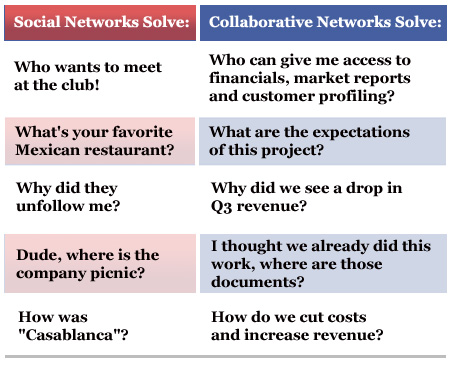We’ve heard some people say, “Why should I use a social networking software platform inside my business firewall, when I can just ask my company to collaborate on Facebook for free?”
There is a good reason to why social networking and business collaboration software platforms exist, and they are built for very different purposes.
Oliver Marks did a great post on “Collaborative Networks Vs Social Networks,” which brings out the stark contrast between the two, and this simple illustration by Aaron Fulkerson of MindTouch reminds us what they are for:
I am not saying that you can’t get collaborative work done by starting a group on Facebook, or you can’t have a productive business discussion on Twitter. But, there are distractions. The components used in a platform for social interaction and business collaboration may be the same — blogs, wikis, groups, forums, discussions, file sharing, instant messaging and more — but that’s where the similarities end.
Collaboration networks are purposely built for enabling it’s members to use the platform to work together towards their professional goals. While some will still argue “why do I need a separate platform?”, it does help channel the collaborative energies in the right direction. There is a reason why people still prefer to hold professional discussions on Linkedin and still prefer to discuss photography on Flickr, while there are sites that can let you do both. There needs to be some level of focus, and when a collaborative network is built around the business or enterprise itself, the interaction is automatically channeled toward what the platform was created for — your business.
Then, there is the other extreme end, when businesses take their existing enterprise collaboration software (which has their email suite and instant messaging) and simply add a wiki and a blog to it and dub it a “social business collaboration software platform.”
Painting stripes on a horse doesn’t make it a Zebra, and adding a wiki to an enterprise messaging suite doesn’t make it “social”. But that’s a whole other discussion.
For now, let’s settle on the fact that social networks will remain a social place, even if you do use it for your business. However, business collaboration needs its own dedicated place — without the distractions. It’s just more productive that way.
width=”660″>
We’ve heard some people say, “Why should I use a social networking software platform inside my business firewall, when I can just ask my company to collaborate on Facebook for free?”
There is a good reason to why social networking and business collaboration software platforms exist, and they are built for very different purposes.
Oliver Marks did a great post on “Collaborative Networks Vs Social Networks,” which brings out the stark contrast between the two, and this simple illustration by Aaron Fulkerson of MindTouch reminds us what they are for:
I am not saying that you can’t get collaborative work done by starting a group on Facebook, or you can’t have a productive business discussion on Twitter. But, there are distractions. The components used in a platform for social interaction and business collaboration may be the same — blogs, wikis, groups, forums, discussions, file sharing, instant messaging and more — but that’s where the similarities end.
Collaboration networks are purposely built for enabling it’s members to use the platform to work together towards their professional goals. While some will still argue “why do I need a separate platform?”, it does help channel the collaborative energies in the right direction. There is a reason why people still prefer to hold professional discussions on Linkedin and still prefer to discuss photography on Flickr, while there are sites that can let you do both. There needs to be some level of focus, and when a collaborative network is built around the business or enterprise itself, the interaction is automatically channeled toward what the platform was created for — your business.
Then, there is the other extreme end, when businesses take their existing enterprise collaboration software (which has their email suite and instant messaging) and simply add a wiki and a blog to it and dub it a “social business collaboration software platform.”
Painting stripes on a horse doesn’t make it a Zebra, and adding a wiki to an enterprise messaging suite doesn’t make it “social”. But that’s a whole other discussion.
For now, let’s settle on the fact that social networks will remain a social place, even if you do use it for your business. However, business collaboration needs its own dedicated place — without the distractions. It’s just more productive that way.




![[New Podcast] How Social Team Collaboration Software can Work in the Real World [New Podcast] How Social Team Collaboration Software can Work in the Real World](https://axerosolutions.com/assets/Uploaded-CMS-Files/3cba4d0c-8e55-4b53-8f56-323bf99a9016.jpg)



